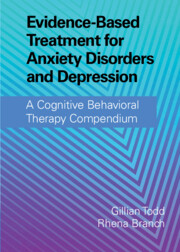 Evidence-Based Treatment for Anxiety Disorders and Depression
Evidence-Based Treatment for Anxiety Disorders and Depression from Part Six - Specialist Applications of Cognitive Behavioral Therapy for Anxiety Disorders and Depression
Published online by Cambridge University Press: 06 January 2022
This chapter provides an evidence-based overview of predominantly cognitive behavioral interventions for common mental disorders, that is, anxiety and depression, undertaken in the field of intellectual disabilities (ID). The evidence was generated by reviewing international publications between 1980 and 2020 which identified the use of cognitive behavioral therapy (CBT), including third wave CBT therapies, and was also informed by our extensive clinical practice in the field of ID. The first section provides an outline of the historical and sociological context of psychological therapies and the possible barriers to CBT in an ID population. The chapter includes a summary of how intellectual disabilities, depression, and anxiety disorders are defined. It considers key issues, problems and solutions associated with applying CBT and its associated approaches in an ID population. Finally, two case vignettes introduce the reader to CBT techniques to illustrate ideas that will help clients using CBT to bring about a reduction in self-defeating behaviors. With the aid of a support worker and electronic sources, there is a much broader range of resources to help client and therapist journey and support the therapeutic alliance.
To save this book to your Kindle, first ensure no-reply@cambridge.org is added to your Approved Personal Document E-mail List under your Personal Document Settings on the Manage Your Content and Devices page of your Amazon account. Then enter the ‘name’ part of your Kindle email address below. Find out more about saving to your Kindle.
Note you can select to save to either the @free.kindle.com or @kindle.com variations. ‘@free.kindle.com’ emails are free but can only be saved to your device when it is connected to wi-fi. ‘@kindle.com’ emails can be delivered even when you are not connected to wi-fi, but note that service fees apply.
Find out more about the Kindle Personal Document Service.
To save content items to your account, please confirm that you agree to abide by our usage policies. If this is the first time you use this feature, you will be asked to authorise Cambridge Core to connect with your account. Find out more about saving content to Dropbox.
To save content items to your account, please confirm that you agree to abide by our usage policies. If this is the first time you use this feature, you will be asked to authorise Cambridge Core to connect with your account. Find out more about saving content to Google Drive.